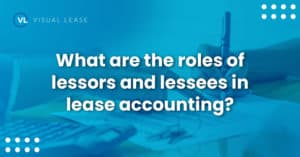
Table of Contents
Under a contractual lease obligation, be it commercial real estate, equipment or vehicles, there is always a lessor and a lessee. A lease is generally defined as a contractual arrangement in which one party, the lessor, provides an asset for use by the other party, the lessee. This arrangement is based on periodic payments for an agreed amount of time. Lease contracts play an important role in the day-to-day of most organizations. But does your business thoroughly understand the responsibilities of a lessee vs lessor? What about the benefits? These answers are critical to maintaining accurate and healthy lease accounting.
What is a lessee?
A lessee is an individual or entity that rents or leases property, equipment, or other assets from another party. In a lease agreement, the lessee is granted the right to use the leased asset for a specified period of time in exchange for regular payments, typically referred to as rent or lease payments.
What is a lessor?
In a lease agreement a lessor is an individual or entity that owns an asset and leases or rents it out to another party in exchange for regular payments, usually called rent or lease payments.
Who is the lessor and who is the lessee in a lease agreement?
In simple terms:
- The lessor provides the asset and retains ownership
- The lessee pays to use the asset
Benefits for a lessor vs lessee
Lease contracts offer distinct advantages for both lessors and lessees, contributing to their respective financial strategies and operational efficiencies.
Benefits for a lessor:
- Income Generation: By leasing out assets, lessors can generate consistent income through periodic lease payments, providing a steady revenue stream.
- Asset Utilization: Lessors can maximize the utilization of their assets by leasing them out to lessees, ensuring that the assets are not idle and generating returns.
- Risk Mitigation: Lessor retains ownership of the asset, allowing them to mitigate certain risks associated with ownership, such as maintenance and depreciation.
- Portfolio Diversification: By leasing out multiple assets across various industries or sectors, lessors can diversify their investment portfolio and reduce overall risk.
Benefits for a lessee
- Cost-Efficiency: Lessees can access and use high-value assets without the need for significant upfront capital investment, preserving their cash flow for other business operations.
- Flexibility: Leasing offers flexibility in terms of asset usage, allowing lessees to adapt to changing business needs without being tied down by long-term ownership commitments.
- Up-to-Date Technology: Leasing enables lessees to access the latest technology and equipment without the burden of owning outdated or obsolete assets, ensuring they remain competitive in their respective industries.
- Asset Management: Lessees can benefit from simplified asset management, as maintenance and upkeep responsibilities often fall on the lessor, reducing operational burdens.
How to approach accounting for lease agreements for lessor or lessee
Although different types of leases exist, such as finance and operating leases, the obligations have one thing in common. When it comes to lease accounting, leases must be reported accurately to meet regulatory compliance standards.
Lessor accounting obligations
Accurate accounting is vital to the health of any organization. As a lessor, accounting accuracy requires correctly classifying your leases, whether as sales-type, direct financing or operating.
Under lease accounting standard ASC 842, ownership transfers to the lessee for accounting purposes for sales-type and direct financing leases. Sales-type leases require lessors to derecognize the underlying asset and instead recognize the lease’s net investment, selling profit or loss arising from the lease, and track the balance and interest income over time. Lessors record direct financing leases in a similar manner but defer the asset’s profit or loss.
Operating leases give the lessee the right to use the asset but not ownership of it. Therefore, lessors record the asset, its related depreciation and lease payments in the books.
Lessee accounting obligations
Lessees must classify their leases as either finance or operating under the ASC 842 lease accounting standard. Both types of leases must appear in the organization’s balance sheet unless the term is 12 months or less, which is considered a short-term lease. For operating leases, lessees are expected to record payments as operating costs on the organization’s income statement.
Impact of ASC 842 for lessors and lessees
How lease agreements are presented on balance sheets has changed for both lessors and lessees under ASC 842. Lessees now need to list all leasing obligations, including operating leases, on the balance sheet, categorizing them as either operating or finance leases. Lessors, who were already classifying leases, are less affected. Accurate classification and accounting are essential, and lease management software can assist in meeting these new requirements.
Whether you are a lessor or a lessee, using a robust software solution like Visual Lease can help maintain accurate lease accounting and protect the financial health of your business.























